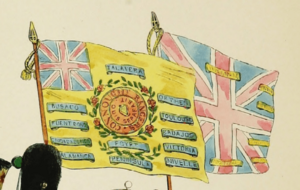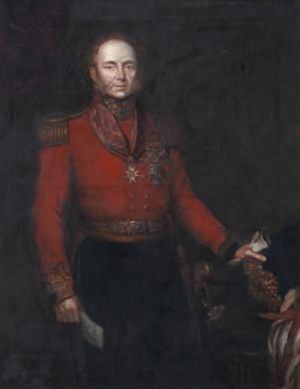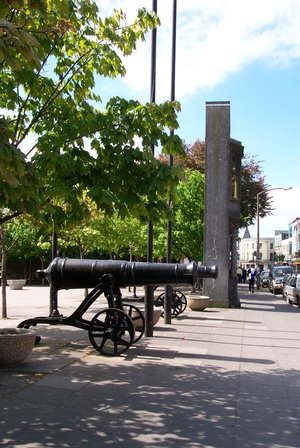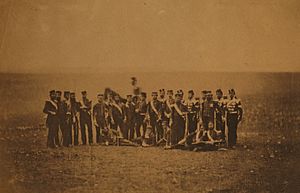88th Regiment of Foot (Connaught Rangers) facts for kids
Quick facts for kids 88th Regiment of Foot (The Connaught Rangers) |
|
|---|---|

Regimental Colours
|
|
| Active | 1793–1881 |
| Country |
|
| Branch | |
| Type | Line Infantry |
| Role | Line Infantry |
| Size | 1 battalions (two battalions 1805–1816) |
| Garrison/HQ | Renmore Barracks, Galway |
| Nickname(s) | The Devils Own |
| Motto(s) | Quis Separabit ("Who shall separate us?") |
| Engagements | |
The 88th Regiment of Foot (Connaught Rangers) was a famous group of soldiers in the British Army. It was formed in 1793. Later, in 1881, it joined with another group, the 94th Regiment of Foot, to become the Connaught Rangers. This happened because of changes called the Childers Reforms.
Contents
History of the Connaught Rangers
How the Regiment Started

The 88th Regiment of Foot (Connaught Rangers) was created in Connacht, Ireland. It was started by John Thomas de Burgh on September 25, 1793. This was because of worries about the French Revolution.
The regiment first went to the Netherlands in 1794. They tried to defend the country against the French, but it was not successful. In 1795, they sailed to the West Indies. After a difficult journey, some of their soldiers helped capture Grenada. They also helped in the fight for Saint Lucia. They returned to England in 1796.
In 1799, the regiment went to India. They arrived in Bombay in June 1800. From India, they sailed to Egypt in December 1800. They were part of the Egyptian Campaign. They reached Cairo on the day the French soldiers gave up. The regiment came back to England in May 1803.
Fighting in the Napoleonic Wars

A second group, called a battalion, was formed in Scotland in November 1805. The 1st Battalion sailed to the Cape of Good Hope in November 1806. Then, in April 1807, they went to South America. They were part of a difficult mission led by Sir Home Popham. They fought in an unsuccessful attack on Buenos Aires in July 1807.
During this battle, two companies were told to remove parts from their guns. This made them unable to fire. After a long fight, the battalion had to surrender. Most of the soldiers were later released and returned to England in November 1807.
The 1st Battalion arrived in Portugal in March 1809. They were there to fight in the Peninsular War. They helped the Portuguese army push the French out of Oporto. In July 1809, they held their ground bravely at the Battle of Talavera.
At the Battle of Bussaco in September 1810, the battalion made a brave charge with their bayonets. This attack pushed the French soldiers back. Sir Arthur Wellesley, a famous general, saw the charge. He told their leader, Lieutenant-Colonel John Wallace, that it was a very brave charge.
The 1st Battalion then moved back with Wellesley's army to the Lines of Torres Vedras. In May 1811, Lieutenant-Colonel Wallace led another bayonet charge at the Battle of Fuentes de Oñoro. They drove the French army out of the village.
The regiment then fought in the Siege of Ciudad Rodrigo in January 1812. They also climbed the walls of the fortress at the Siege of Badajoz in April 1812. At the Battle of Salamanca in July 1812, they were at the center of the attack. They defeated the French soldiers. At Salamanca, they captured a special musical instrument called a "Jingling Johnny."
The 1st Battalion also took part in the Siege of Burgos in September 1812. They fought at the Battle of Vitoria in June 1813. They then chased the French army into France. They fought in battles like the Battle of the Pyrenees (July 1813), the Battle of Nivelle (November 1813), and the Battle of the Nive (December 1813). They also fought at the Battle of Orthez (February 1814) and the Battle of Toulouse (April 1814).
In June 1814, they sailed to North America for the War of 1812. They arrived too late for the last battle of that war. So, they went to Belgium in May 1815. They returned home in 1817.
Meanwhile, the 2nd Battalion went to Lisbon in 1809 for the Peninsular War. They only fought in the Battle of Sabugal in April 1811. Most of their soldiers then joined the 1st Battalion. The rest of the 2nd Battalion returned to the UK and was later disbanded in 1816.
The Victorian Era and Beyond

The regiment was sent to the Ionian Islands in 1825 and came back in 1836. They went to Malta in 1840, then to the West Indies in 1847, and Nova Scotia in 1850. They returned home in 1851.
The regiment also fought in the Crimean War. They saw action at the Battle of Alma in September 1854. They also fought at the Battle of Inkerman in November 1854. They were part of the Siege of Sevastopol in the winter of 1854. To honor their service in the Crimean War, two cannons were given to the City of Galway. These cannons are still on display today.
After the Crimean War, the regiment returned home in 1856. But in 1857, they were sent to India. This was because of the Indian Rebellion. In November 1870, the regiment sailed home from Bombay. During their 13 years in India, many soldiers died, mostly from illness.
The regiment was next sent to South Africa in 1877. They fought in the 9th Xhosa War and the Anglo-Zulu War. They returned to India in 1879.
In the 1870s, changes were made to the British Army. The 88th Regiment was linked with another group, the 87th (Royal Irish Fusiliers) Regiment of Foot. They shared a training center in Galway. On July 1, 1881, the 88th Regiment joined with the 94th Regiment of Foot. Together, they became the Connaught Rangers.
Battle Honours
These are some of the important battles and campaigns the regiment was honored for:
- Napoleonic Wars: Egypt (with a sphinx symbol)
- Peninsular War: Talavera, Busaco, Fuentes d'Onor, Ciudad Rodrigo, Badajoz, Salamanca, Vittoria, Nivelle, Orthes, Toulouse, Peninsula
- Crimean War: Alma, Inkerman, Sevastopol
- Central India
Victoria Cross
- Major Hans Garrett Moore received the Victoria Cross for his bravery in the 9th Cape Frontier War on December 29, 1877.

